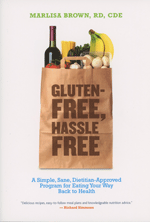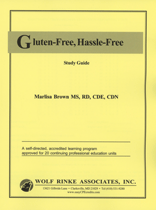|
Gluten-Free, Hassle-Free
Marlisa Brown, RD, CDE, CDN
(Book, 366 pgs and study guide, 32 pgs.) About 1% of
the world population is suffering from celiac disease, and that rate
is increasing at an alarming rate. Yet patients are often confronted
with complicated and conflicting information. This down-to-earth program
provides a wealth of practical solutions, strategies and shortcuts that
will enable you to help your patients live gluten-free and eat their
way back to health. More specifically you will learn how to:
- Evaluate appropriate tests to diagnose celiac disease.
- Distinguish between celiac disease and non-celiac gluten-sensitivity.
- Plan safe gluten-free meals.
- Recognize potential nutritional issues associated with gluten-free
foods.
- Plus much, much more.
For more information and customer comments, click
here.
Approved/Accepted by CDR,CBDM
For RDs & DTRs: Suggested Learning Need Codes for the Prof.
Dev. Portfolio:
2000, 2020, 2050, 2070, 2100, 3000, 3020, 3080, 3090, 4000, 4040, 4150,
4190, 5000, 5110, 5120, 5280, 5460, 8090, 8100
Share with a friend and Save!
Click here for important information about
sharing.
To order an additional Reporting Form click below:
| C233F |
20 CPEUs |
$50.00 |

|
Gluten-Free,
Hassle-Free
Marlisa Brown, RD, CDE, CDN
©2012 Wolf Rinke Associates. No part of this
publication may be reproduced, stored in a retrieval system, or transmitted
in any form or by any means, electronic, mechanical, photocopying,
recording, scanning, or otherwise, without the prior written permission
of the Publisher.
CUSTOMER COMMENTS
Jacqueline Gutierrez: The book did a great job of explaining the symptoms and issues related to the the diagnosis of celiac disease. It also provided advice that could immediately benefit clients.
Terri L Sakelaris: I am seeing more and more patients and this is a great way to get the education with my busy life.
Teresa Gallagher: For my counseling needs, the recipes and food substitutions were excellent. It is an excellent course without getting too scientific with information I will use on a daily basis.
Marianne Tomashefski: My sister has been diagnosed with celiac disease. My mother has a non-celiac gluten sensitivity; this course was invaluable to me because I am more confident that I have the best information to educate them. Thank you for offering this course!
Camille Hoy: I learned a lot of new information in an easy to follow format! Good course!
Frances Townsend Gilmore: My husband has been on a gluten free diet and this was most helpful of all I've seen.
OVERVIEW AND INTRODUCTION
Celiac disease is a relatively new disease. Approximately
10,000 years ago gluten was not even part of the human diet. After
people began cultivating their food supply, they began to include
grains i.e. gluten, into their diet. More recently, cross breeding
of different types of grains has increased the amount of gluten found
in some of these grains. It has been estimated that currently about
1 percent of the population in the world suffer from celiac disease,
and there is evidence that the prevalence continuous to increase at
an alarming rate. Those who have celiac disease cannot consume gluten,
which is a protein found in wheat, rye and barley, in any form or
any amount including gluten found in food, supplements, medications,
cosmetics, dental products, etc..
Celiac disease is an autoimmune disorder which attacks the body after
ingestion of gluten. It attacks through the gastro intestinal system
and can cause a wide range of symptoms, disorders, and diseases which
will vary from person to person. Over half of those suffering from
celiac disease will experience gastro-intestinal problems after the
ingestion of gluten which may manifest in symptoms such as gas, bloating
diarrhea or constipation. Those who don't suffer from gastro-intestinal
problems can seem to be symptom free, even though their immune system
may be an attacked. Since symptoms often do not occur immediately
after exposure to gluten, it is difficult to link reactions to a specific
food. Hence these individuals may suffer from a wide range of seemingly
non-related symptoms which often makes it difficult to identify those
who have celiac disease. In addition there are many limitations in
current diagnostic methods, which cause many people to suffer without
having been diagnosed.
Those who are diagnosed will improve on a gluten-free diet, which
currently is the only treatment for celiac disease. In addition, there
are many people who do not have celiac disease who also need to follow
a gluten-free diet. This includes; those with a gluten allergy, (celiac
disease is not an allergy), and those with non-celiac gluten sensitivity
(which has recently been discovered). These individuals may have many
symptoms which are similar to those who suffer with celiac disease
and sometimes it is difficult to determine if it is one of these issues
or simply undiagnosed celiac disease. Others are using a gluten free
diet to help treat children with behavioral disorders (currently there
is research being done in this area). Yet others have adapted a gluten-free
diet as a new diet plan, because it makes them "feel better."
As a result the demand for gluten-free foods is increasing at an incredible
rate.
Gluten-free living for those who need to be gluten-free 100% of time
can be a seemingly overwhelming task because they must avoid all cross
contamination. This includes knowing how to prepare "safe"
foods, as well as dealing with the challenges of reading food labels,
and identifying safe food sources at school, work, restaurants and
while traveling.
This self-directed accredited learning program will help you identify
those who need to follow a gluten-free diet, enable you to diagnose
gluten related health disorders, and provide you with tools to assist
your clients determine safe foods, address cross contamination issues
found in multitude of settings, while determining strategies for planning
healthier, diverse meal plans.
To get the most out of this learning program, it is suggested that
you follow these steps:
-
Review the objectives in the study guide.
-
Read and study the Gluten Free, Hassle Free book.
-
Assess what you have learned by answering the self-assessment
questions in this study guide.
-
Compare your answers to the answer key, which is
located at the end of the study guide. If you scored at least 80%
(60) correct, you have completed the program and are ready to transfer
your answers to the CONTINUING PROFESSIONAL EDUCATION REPORTING
FORM. If you scored less than 80% (60) correct, re-read the appropriate
sections of the book until you score at least 80% correct.
After you have successfully completed the program, complete
the CPEU REPORTING FORM and:
Submit on-line at www.easyCPEcredits.com,
or mail to: Wolf Rinke Associates, 721 Valley Forge Road #486, Valley Forge, PA 19481,
or fax to: (410) 531-9282
We will e-mail your Certificate of Completion.
When you submit your CPEU Reporting Form to us via mail,
fax or www.easyCPEcredits.com, be sure to write your correct email
address in the space provided on the CPE Reporting Form. If writing
by hand, be sure to print your e-mail address clearly.
To ensure that our e-mails are delivered to your inbox
(instead of your junk/spam folders), please add cpesupport@wolfrinke.com
to your Address Book or Safe List of allowed email senders. Also,
be sure to allow attachments from this email address.
Gluten-Free Regards,
Marlisa Brown MS RD CDE CDN
LEARNING OBJECTIVES
Upon completion of this accredited, self-directed learning program
you will be better able to:
-
Identify typical symptoms of celiac disease.
-
Evaluate appropriate tests to diagnose celiac disease.
-
Explain issues involved with diagnosing celiac disease.
-
Distinguish between celiac disease and non-celiac
gluten-sensitivity.
-
Assess genetic tests used in testing for inherited
risk for celiac disease.
-
Identify non-typical symptoms of celiac disease.
-
Recognize diseases associated with celiac disease.
-
Plan safe gluten-free meal plans.
-
Recommend safe gluten-free food choices.
-
Help clients deal with emotional challenges associated
with adhering to a gluten-free diet.
-
Implement gluten-free recipe modifications.
-
Recommend changes to make cooking equipment and
foods safe for gluten-free preparation.
-
Recognize potential nutritional issues associated
with gluten-free foods.
-
Monitor and evaluate patient's compliance to gluten-free
meal plans.
-
Suggest strategies for dining out gluten-free.
-
Help clients plan for outside eating events such
as travel, work meetings, and family events.
-
Provide a checklist for parents for day care, parties,
and outside events.
-
Teach clients to read food labels to identify safe
gluten-free choices.
-
Specify issues associated with the proposed gluten-free
labeling laws.
-
Discuss safe gluten-free choices on ethnic menus.
TABLE OF CONTENTS
Part I Making the Change
1 Is Your Diet Putting Your Health at Risk?3 3
2 Learning the Basics (But Not the Needless Details) of Living Gluten-Free
15
3 Discovering What You Can and Can't Eat 35
4 Planning and Cooking Simple Gluten-Free Meals71 71
5 Quick and Easy Substitutions103 103
6 Reading and Translating Labels 119 119
7 Handling Your Feelings-and Knowing You're Not Alone 131
Part II Making Gluten-Free Living Simple
8 Finding the Hidden Gluten in Food 141
9 Eating a Balanced Gluten-Free Diet 149
10 Using Gluten-Free Alternatives 175
11 Cooking Gluten-Free Dishes with Flair 187
12 Dining Out without Gluten 279
Part III Making Your Life Healthy, Happy, and Uncomplicated
13 Making It Easy for Family and Friends 331
14 Making It Easy for Yourself 337
15 Learning More about Gluten and Your Health 341
ABOUT THE AUTHOR
Marlisa Brown is a registered dietitian, certified diabetes educator
and chef. She is also an international speaker, with over thirty years
of culinary experience. Marlisa has made numerous television appearances,
including five years on "International Healthy Cooking"
for The American Heart Association. In addition she is a member of
the dLife TV Professional Council. Marlisa has a graduate degree in
nutrition and a bachelor's degree in marketing from C.W. Post/Long
Island University, and has also studied at the Culinary Institute
of America.
Marlisa is president of Total Wellness Inc., a private
nutrition consulting company specializing in culinary programs, corporate
wellness, gastrointestinal disorders, celiac disease, diabetes, weight
loss, preventive medicine, medical nutrition therapy, food allergies,
and sports nutrition. Some of her corporate contacts include the NY
Jets, Kennedy Space Center, Pratt and Whitney, Honeywell, Hofstra
& Adelphi Universities Lilco, Guardian Life, Brookhaven National
Labs, Goldman Sachs, Dean Witter Reynolds, Pall Corp, Bank of New
York, Sony, Liz Claiborne, and Ethicon. As part of her foodservice
background Marlisa has worked as a Wellness Coordinator for Lackmann
Culinary Services over a ten year period and she has over 30 years
culinary experience.
Marlisa author of "Gluten-Free Hassle Free"
and "Easy, Gluten-Free". In addition she has contributed
to many publications including, Salute, Scholastic, Shape, Food Service
Management, Newsday, Parenting Magazine, Weight Training for Dummies,
and Sports Nutrition Medicine and Rehabilitation. She has also written
many programs including, Richard Simmons' Food Mover Program, cookbooks,
recipe cards and web site, Kathy Smiths' Project You II for Diabetes,
Jorge Cruises' The 3-Hour Diet Cookbook, Leslie Sansones' Walk Away
the Pounds and the Turbo cooker.
She is the current nominating chair for Dietitians Integrative
and Functional Medicine with The American Dietetic Association, chair
of the nutrition section for The International Association of Culinary
Professionals, and has served as an officer on many boards, including
past president, media representative, and public relations chair of
the New York State Dietetic Association. Marlisa is a recipient of
the 2011 Diabetes Educator of the Year from the Diabetes Care &
Education Practice Group of The American Dietetic Association, The
Emerging Dietetic Leader Award from the American Dietetic Association,
Dietitian of the Year from The Long Island Dietetic Association, Best
Of Long Island from the L.I. Press 2008/2009/2010/2011, and the community
service award from C.W. Post/Long Island University.
Return to the top of page
If you prefer to order by phone, mail
or fax click below
or click here to contact us with
other questions.
For information about our other products and
services return to the sidebar at the top of the page.
|
|
|



